DACF Home → Bureaus & Programs → Maine Natural Areas Program → Communities, Plants, and Animals → Invasive Plants → Autumn Olive
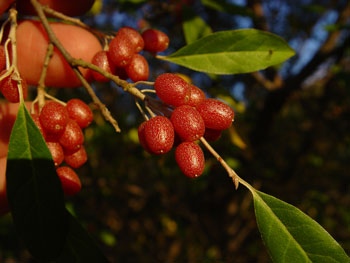 Autumn olive fruit
Autumn olive fruit
Autumn Olive
Elaeagnus umbellata
2019 Status in Maine: Localized. Very Invasive.
Description: Perennial, deciduous shrub, up to 10-15' tall and wide, usually very branched, with silvery and/or brown scales along twigs. Some plants bear 1"+ woody spines. Leaves: Simple, alternate, tapered at both ends (distal end may be blunt-tapered), 1-3" long, leaf edges entire but crinkly/wavy. Lower surface with slivery and brown scales (use hand lens or may be visible with naked eye). Flowers: Fragrant, white to cream to light yellow. Tubular base with 4 pointed petals. Occur in small clusters along twigs at leaf bases, May-June in Maine. Fruit: Roundish, <½" wide, can be slightly longer than wide, light colored scales on surface, start brown and mature through yellow, orange, to red around September.
Native range: China, Korea, Pakistan, and Japan. How arrived in U.S.: As an ornamental; also for food and cover for wildlife.
Reproduction: By seed. Birds and mammals consume fruits and disperse seed. Longevity in seed bank is not known. Plants are mostly dioecious but there are occasional exceptions with male and female flowers on the same plant.
Habitat: Commonly found in old fields, roadsides, forest edges, and fragmented forests. Not tolerant of wet soils. Prefers sun but will germinate in partial or full shade, though growth and reproduction may be slowed. Autumn olive is a nitrogen-fixing species and can therefore colonize very low-nutrient soils.
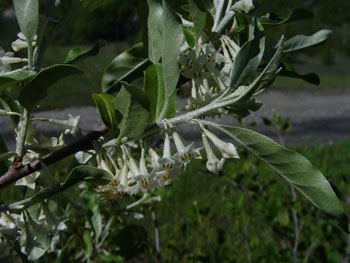 Autumn olive branch with flowers
Autumn olive branch with flowers
Similar native species: Could be confused with shrubby willows, but those lack silvery and brown scales on twigs and leaves, and have very different flowers and fruit.
Similar non-native species: Shrubby honeysuckles also have round, red fruits, but leaves are opposite and more clearly oval (less tapered at ends) and lack scales. Russian olive is similar, with leaves silvery on upper and lower surfaces, but is not naturalized in Maine.
Documented Ecological Impacts
- Autumn olive can form dense thickets and change native habitat, including forest understory. Autumn olive's nirogen fixing abilities give it a competitive advantage over native species, especially in poor soils. (Munger, G.T. 2003. Elaeagnus umbellata. In: Fire Effects Information System. U.S. Department of Agriculture, Forest Service)
- Autumn olive produces prolific berries that are attractive to wildlife, however, these fruits are high in carbohydrates and low in fats and proteins. Autum olive fruit provides poor nutritional value to birds, which can slow migration and make birds vulnerable to other risks. (Autum Olive Fact Sheet. 2020. PennState Extension. and Autumn Olive Fact Sheet. 2021. Blue Ridge Partnership for Regional Invasive Species Management)
- Autumn olive leaves in wet depressions may increase production of West Nile virus carrying mosquitoes. (Gardner, A.M., et al. 2015. Asymmetric effects of native and exotic invasive shrubs on ecology of the West Nile virus vector Culex pipiens (Diptera: Culicidae) Parasite Vectors 8: 329)
Fact Sheets and Identification Links
- Michigan DNR Best Control Practices for Autumn Olive
- University of Maryland identification video (3:08)
- Vermont Dendrology identification video (2:57)
- University of Massachusetts identification video (1:41)
- Go Botany page for Elaeagnus umbellata
Control Methods
Small plants and seedlings may be pulled up by the roots when soil is moist; larger plants can be cut, but re-sprouting will occur*. Persistent cutting or burning of the the root crown multiple times during the growing season over several years may kill the plant, but diligence is required. Mowing can prevent seedlings from establishing. Goats and sheep will browse it but repeated, heavy damage over multiple years is required to kill established shrubs. Herbicides† are effective as foliar applications (glyphosate or triclopyr solution), cut-stump application (glyphosate or triclopyr solution applied immediately after cutting except in early spring), or basal bark application (triclopyr ester in bark oil).
* Correctly dispose of all plant parts↵ † Follow all label directions when using herbicides↵Control Technique Video Demonstrations
- Herndon Environmental Network, Virginia (5:05), identification, ecology, mechanical removal, cut-stem herbicide application, native alternatives
- White Oak Nursery, New York (3:28), cut-stump/herbicide using forest clearing saw, please note use of proper safety equipment including chaps, boots, gloves, and face shield
Please email invasives.mnap@maine.gov if you have questions about invasive species in Maine
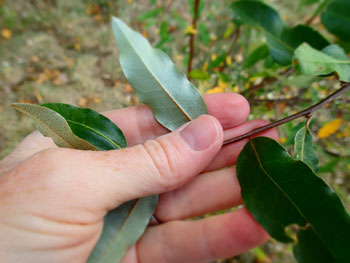 Autumn olive leaves
Autumn olive leaves
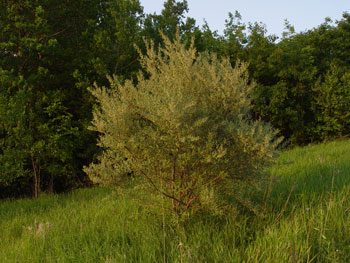 Autumn olive growth habit in field
Autumn olive growth habit in field
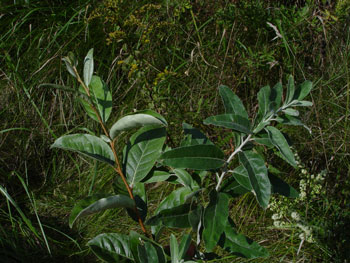 Autumn olive branch on left, Russian olive on right
Autumn olive branch on left, Russian olive on right
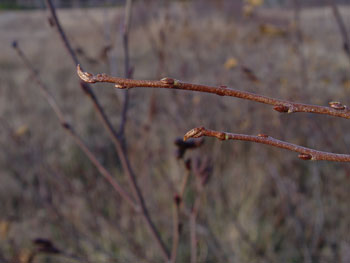 Autumn olive growth twig
Autumn olive growth twig
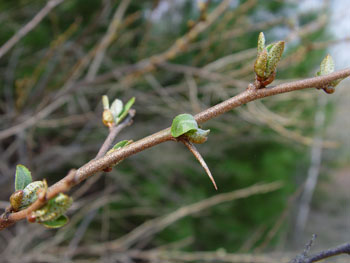 Autumn olive early spring branch
Autumn olive early spring branch
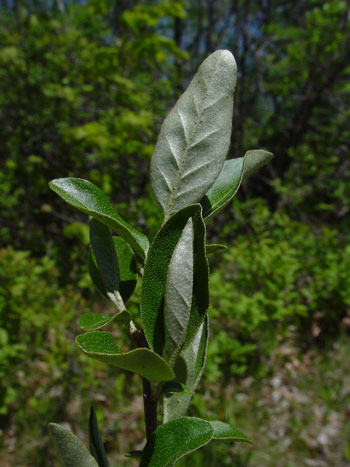 Autumn olive leaves
Autumn olive leaves